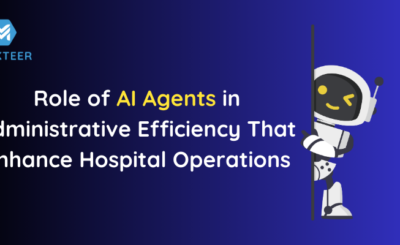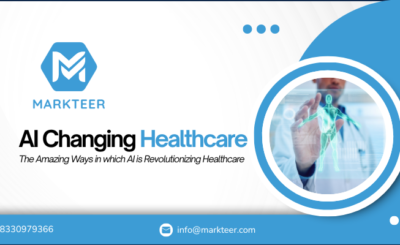The healthcare sector is increasingly overwhelmed with data, and artificial intelligence (AI) is stepping in to streamline its interpretation. Modern healthcare generates vast quantities of data from diverse sources, creating a complex landscape for healthcare providers. Let’s look at some key statistics and insights that highlight the importance of AI-driven data analytics in transforming healthcare decision-making.
The Data Explosion in Healthcare
Electronic Medical Records (EMRs):
A 2021 report by HIMSS shows that over 96% of U.S. hospitals have adopted electronic medical records (EMRs), creating vast volumes of structured and unstructured data with every patient interaction. In addition, IDC reports that healthcare data is growing at a compound annual growth rate (CAGR) of 36% and will reach 2.3 zettabytes by 2025, making efficient data analysis tools like AI indispensable.
Diagnostic Imaging:
AI is revolutionizing radiology by enhancing diagnostic precision. The global medical imaging market is projected to grow from $43.1 billion in 2020 to $62.9 billion by 2025. AI algorithms have shown remarkable accuracy; for instance, Google’s deep learning model detected lung cancer with 96% accuracy, surpassing the performance of expert radiologists. Tools like Aidoc and Zebra Medical Vision are now widely used in hospitals to identify strokes and other conditions in CT scans with up to 90% accuracy.
Wearable Technology:
Wearable health devices generate real-time patient data such as heart rate and oxygen levels. The wearable healthcare tech market is expected to hit $67 billion by 2025 . According to a Pew Research Center study, 21% of U.S. adults regularly use fitness trackers, a figure expected to grow as healthcare systems further integrate wearables for continuous monitoring.
Genomic and Molecular Data:
According to Gartner, the cost of sequencing a human genome has dropped from $100 million in 2001 to under $1,000 today. With this affordability, genomic sequencing has become mainstream in hospitals, generating complex datasets. AI is crucial in analyzing these datasets, enabling precision medicine approaches to effectively treat cancer and inherited diseases.
AI’s Role in Data Analytics and Healthcare Decision-Making
Machine Learning (ML):
ML algorithms can predict patient risks and optimize treatment plans. For example, a study in JAMA found that AI models predicted sepsis 48 hours in advance, resulting in a 20% reduction in sepsis-related mortality.
Natural Language Processing (NLP):
NLP allows the transformation of unstructured EMR data into usable insights. Stanford Medicine uses NLP techniques to extract valuable data from doctors’ notes and clinical records. A Harvard Business Review analysis showed that NLP can cut diagnostic time by 40%, significantly improving physician productivity.
Deep Learning and Image Recognition:
Deep learning enables image-based diagnostics. A Nature Medicine study revealed that AI could detect breast cancer in mammograms with 99% accuracy, sometimes outperforming human radiologists. Systems like Zebra Medical Vision are used in hospitals to analyze over 1 million images per year and diagnose conditions such as pneumonia, osteoporosis, and others.
Predictive and Prescriptive Analytics:
McKinsey & Company estimates that predictive analytics can reduce hospital readmissions by up to 25%, while prescriptive analytics help personalize treatment plans for chronic diseases such as diabetes and hypertension.
Real-World Applications and Benefits of AI-Driven Decision-Making
AI in Radiology and Pathology:
AI tools such as Aidoc and Zebra Medical Vision are now deployed in over 200 hospitals worldwide. Zebra alone analyzes over 1 million radiology images annually, helping physicians detect conditions such as early-stage cancers and neurological disorders more accurately and quickly.
Chronic Disease Monitoring:
The American Diabetes Association reports that 34.2 million Americans live with diabetes. AI-integrated glucose monitors to track fluctuations and alert care providers to anomalies, enabling proactive interventions. Likewise, wearable ECG monitors powered by AI can detect atrial fibrillation with 98% sensitivity.
Virtual Health Assistants:
AI chatbots like Babylon Health and Ada help with routine patient interactions. A McKinsey report highlights that virtual health assistants can reduce administrative costs by up to 30% and improve patient satisfaction scores through 24/7 availability.
Drug Discovery and Development:
AI is accelerating the pace of pharmaceutical R&D. Insilico Medicine, for example, used AI to develop a novel fibrosis drug in just 18 months, a dramatic reduction from the standard 5–10 years. Gartner reports that AI-driven drug discovery platforms can cut R&D costs by 30% while improving trial success rates.
Challenges and Barriers to AI Adoption
Data Privacy and Security:
Healthcare data is sensitive and requires robust security. According to a Ponemon Institute study, 68% of healthcare organizations have experienced at least one data breach, emphasizing the need for HIPAA-compliant, secure AI infrastructures.
Interoperability:
Data silos hinder AI integration. The Office of the National Coordinator for Health IT notes that 40% of U.S. hospitals face interoperability challenges, limiting the ability of AI systems to access comprehensive data across care networks.
Explainability and Trust:
Clinician trust is essential. According to a McKinsey survey, 60% of healthcare professionals express concerns about the “black box” nature of some AI models, preferring interpretable systems that support their clinical judgment.
Conclusion
AI transforms healthcare data analysis by turning complex, unstructured data into actionable insights that improve decision-making. From enhancing diagnostic accuracy to enabling predictive analytics, AI empowers healthcare providers to deliver better patient outcomes, streamline operations, and reduce costs. However, addressing challenges related to data privacy, interoperability, and AI explainability will ensure widespread adoption and trust in AI across the healthcare ecosystem.



